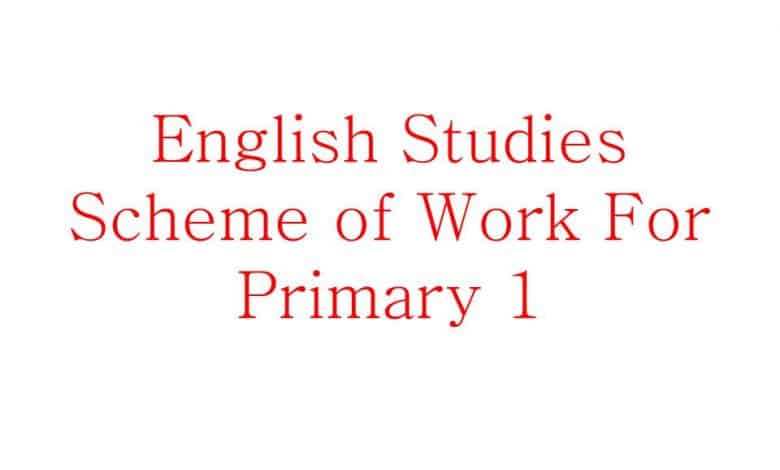Scheme of Work For English Language Primary 1

This article provides you with the English Language scheme of work and the curriculum for the first term, second term, and third term for primary 1 pupil.
First term
Phonological awareness
- Auditory perception and discrimination
- Sounds of domestic animals such as cat, horse dog, cock, cow, goat, etc.
Phonemic Awareness
- Sounds of letters; – Production of basic sounds in given words correctly e.g. /a/, /b/, /d/
Phonemic Awareness II
Pupils should be able to:
- listen to one syllable words and recognizes words that begin with same letter sounds.
- recognize words that end with same letter sounds.
- identify rhyming words.
- identify beginning and end sounds;
- blend sounds to form one syllable words e.g. ex, to, my, do etc, and
- segment and syllable words into separate letter sounds
Phonemic Awareness III
Pupils should be able to:
- sing songs taught
- recite rhymes
- identify letters sounds in songs and rhymes
- recognize rhyming words from given word sets; and
- build rhyming word families
Phonics I
The alphabet:
- sounds of letters of the alphabet /a/ – /3/
- names of all uppercase and lower case letters of the alphabet
- alphabetical order
Phonics II
- Blending sounds of letters to form words e.g. /v/ – an (to form van; or /c/ – an to form can); or /c/ – at to form cat); etc
Phonics III
- Identification of familiar sounds in words e.g. house/mouse; try/fry; cat/bat/hat; etc.
- Combining sounds to form two and three letter words leg. “tonight from “to” and “might; “into” from “in” and “ to”; etc)
Phonics IV
- Decoding strategies
- Sounding out words in text
- Break words into smaller words
- Words parts compound words, diagraphs
- Apply long and short vowels
Fluency I
- Reading aloud with: pacing, intonation, punctuations
- Reading variety of texts (poems, fantasy etc)
- Independent reading
Fluency II
- Recognition of common one letter words (e.g. “a”, and “I”); two– letter (e.g. “s”, “my”); and three- Letter words (e.g. “the”, “was”; “can”)
Second term
Comprehension I
Pupils should be able
- Listening comprehension
- Answering questions from stories
- Making connections and responding to story themes, plots and settings
Comprehension II
- Written comprehension
- Making connections and responding to story themes, plots and settings
Comprehension III
- Reading informational text: pictures, illustrations, tables, charts, graphs etc.
Vocabulary acquisition I
- Reading vocabulary acquisition: Word categories, Colours, Shapes, Foods, Animals, Toys, etc.
- Abbreviation and word endings e.g. Mr. Mrs. Dr. Rev. etc –s, -ed, -es, -ing, etc. – Symbols e.g. N; k; -; +, =; -:, x, %, 8, #; *, etc.
Vocabulary acquisition II
Pupils should be able to:
- explain the concept of synonyms and antonyms
- identify antonyms and synonyms correctly in own speech and in written texts and stories
- identify homonyms
- explain meaning of new words in content – specific texts correctly
- use of new vocabulary and grammatical constructions in own speech
- recognize and understand the meaning of 100-300 new words
- manipulate word families
Concepts of print I
- Parts of a book: front cover, back cover, title, pages, author, etc.
- The alphabets A-Z
Concepts of print II
- Identification of upper and lower case letters
- Punctuation marks – Comma, “, “; – – Full – stop “.”:- – Question mark (?)
Concepts of print III
- Eye movement: reading from left to right, top to bottom, etc.
- Matching oral words to print
Sounds and letters
- Production of basic sounds in given words correctly e.g. /a/, /b/, /d/
- Correct pronunciation of letters of the alphabet e.g. A,B,C
Songs and rhymes
- Clare recitation of various rhymes of depicting nature, care, kindness and love
- Short songs which appeal to children’s sentiments
Read: List of Nursery and Primary School Subjects
Third Term
Simple greetings and commands
- Greetings at home and appropriate time for particular greetings e.g.: Pupil: “Good morning dad, how do you do? Dad: “Good morning Ade, how do you do?
- Greetings at school e.g. Pupil: “Good morning Madam/Sir/Mr. Obi. Teacher: “Good morning Olu, how are you?” Pupil: “I am very well thank you sir”.
- Greetings in the community, neighbours, elders/clan heads, nurse, doctor e.g. “Good afternoon Doctor/Sir/Madam etc.
- Simple commands at home: e.g. ‘wake up!’, ‘go to bed’, ‘greet your daddy’.
Identification of persons and objects
- Introductions such as “What is your name?” “My name is Tinu”. What is your father’s/mother’s/brother’s/sister’s name?”
- Identification of objects at home e.g. bed, mat, radio “What is this?” “ Show me a cup” etc.
Identification of colours and animals
- Identification of major colours: white, red, blue, yellow, black.
- Description of things according to their colours e.g. ‘yellow bag’, ‘red bucket’, “Give me the green book” etc.
- Identification of animals: domestic animals e.g. “Cat, dogs and goats”. wild animals e.g. Lions, Elephants and Hyenas
Expressing possession
Using the possessive my, yours, his, hers, in simple correct sentences e.g.
- This is my pen
- this is your pen
- this is his/her pen
Expressing gratitude and farewell
- Expressing gratitude through role play
- Expressing farewell in various ways and situations
- Expressing farewell
Asking and answer questions
Simple questions and answers, such as:
- What is your name?’ ‘my name is Olu’
- What is your father’s name?’ ‘my father’s name is Ahmed’
Introducing nouns and pronouns
- Nouns: e.g. Lagos, house, Hauwa, etc pronouns e.g. she, they, he, it etc.
Indicating singular/plural forms
